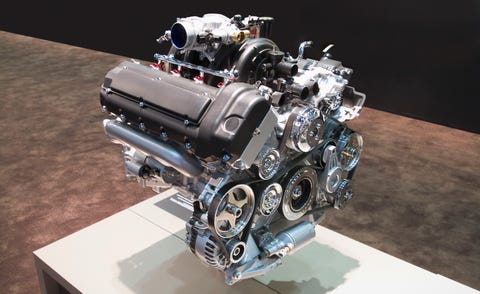Can I Write Off Car Insurance in Muchigan
For most people, a car is a thing they fill with gas that moves them from point A to point B. But have you ever stopped and thought, How does it actually do that? What makes it move? Unless you have already adopted an electric car as your daily driver, the magic of how comes down to the internal-combustion engine—that thing making noise under the hood. But how does an engine work, exactly?
Specifically, an internal-combustion engine is a heat engine in that it converts energy from the heat of burning gasoline into mechanical work, or torque. That torque is applied to the wheels to make the car move. And unless you are driving an ancient two-stroke Saab (which sounds like an old chain saw and belches oily smoke out its exhaust), your engine works on the same basic principles whether you're wheeling a Ford or a Ferrari.
Engines have pistons that move up and down inside metal tubes called cylinders. Imagine riding a bicycle: Your legs move up and down to turn the pedals. Pistons are connected via rods (they're like your shins) to a crankshaft, and they move up and down to spin the engine's crankshaft, the same way your legs spin the bike's—which in turn powers the bike's drive wheel or car's drive wheels. Depending on the vehicle, there are typically between two and 12 cylinders in its engine, with a piston moving up and down in each.
Where Engine Power Comes From
What powers those pistons up and down are thousands of tiny controlled explosions occurring each minute, created by mixing fuel with oxygen and igniting the mixture. Each time the fuel ignites is called the combustion, or power, stroke. The heat and expanding gases from this miniexplosion push the piston down in the cylinder.
Almost all of today's internal-combustion engines (to keep it simple, we'll focus on gasoline powerplants here) are of the four-stroke variety. Beyond the combustion stroke, which pushes the piston down from the top of the cylinder, there are three other strokes: intake, compression, and exhaust.
Engines need air (namely oxygen) to burn fuel. During the intake stroke, valves open to allow the piston to act like a syringe as it moves downward, drawing in ambient air through the engine's intake system. When the piston reaches the bottom of its stroke, the intake valves close, effectively sealing the cylinder for the compression stroke, which is in the opposite direction as the intake stroke. The upward movement of the piston compresses the intake charge.
The Four Strokes of a Four-Stroke Engine

Getty Images
In today's most modern engines, gasoline is injected directly into the cylinders near the top of the compression stroke. (Other engines premix the air and fuel during the intake stroke.) In either case, just before the piston reaches the top of its travel, known as top dead center, spark plugs ignite the air and fuel mixture.
The resulting expansion of hot, burning gases pushes the piston in the opposite direction (down) during the combustion stroke. This is the stroke that gets the wheels on your car rolling, just like when you push down on the pedals of a bike. When the combustion stroke reaches bottom dead center, exhaust valves open to allow the combustion gases to get pumped out of the engine (like a syringe expelling air) as the piston comes up again. When the exhaust is expelled—it continues through the car's exhaust system before exiting the back of the vehicle—the exhaust valves close at top dead center, and the whole process starts over again.
This content is imported from {embed-name}. You may be able to find the same content in another format, or you may be able to find more information, at their web site.
In a multicylinder car engine, the individual cylinders' cycles are offset from each other and evenly spaced so that the combustion strokes do not occur simultaneously and so that the engine is as balanced and smooth as possible.

Getty Images
But not all engines are created equal. They come in many shapes and sizes. Most automobile engines arrange their cylinders in a straight line, such as an inline-four, or combine two banks of inline cylinders in a vee, as in a V-6 or a V-8. Engines are also classified by their size, or displacement, which is the combined volume of an engine's cylinders.
The Different Types of Engines
There are of course exceptions and minute differences among the internal-combustion engines on the market. Atkinson-cycle engines, for example, change the valve timing to make a more efficient but less powerful engine. Turbocharging and supercharging, grouped together under the forced-induction options, pump additional air into the engine, which increases the available oxygen and thus the amount of fuel that can be burned—resulting in more power when you want it and more efficiency when you don't need the power. Diesel engines do all this without spark plugs. But no matter the engine, as long as it's of the internal-combustion variety, the basics of how it works remain the same. And now you know them.
Time to Give Your Ride a Spring Cleaning? Try the Meguiar's Products We Use on Our Fleet

Meguiar's Ultimate Wash & Wax

Meguiar's Ultimate Quik Detailer

Meguiar's Water Magnet Microfiber Towel

Meguiar's Ultimate Interior Detailer
This content is created and maintained by a third party, and imported onto this page to help users provide their email addresses. You may be able to find more information about this and similar content at piano.io
Can I Write Off Car Insurance in Muchigan
Source: https://www.caranddriver.com/features/a26962316/how-a-car-works/
0 Response to "Can I Write Off Car Insurance in Muchigan"
Post a Comment